D-Day — Anatomy of a Second Wave
Canadian landings captured by RCN photographer
by Glenn Warner (cinematographer, photographer, photo historian)
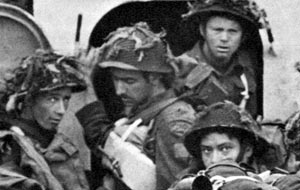 In the lead up to D-Day, Royal Canadian Navy photographer Gilbert Milne rigourously documented the load-in of Canadian army elements onto Canadian navy vessels. As the ships weighed anchor to turn towards the Normandy coast, Milne climbed aboard an infantry troop-carrier and created a definitive photographic time capsule recording Canada's contribution to, arguably, the most pivotal moment of the 20th Century.
In the lead up to D-Day, Royal Canadian Navy photographer Gilbert Milne rigourously documented the load-in of Canadian army elements onto Canadian navy vessels. As the ships weighed anchor to turn towards the Normandy coast, Milne climbed aboard an infantry troop-carrier and created a definitive photographic time capsule recording Canada's contribution to, arguably, the most pivotal moment of the 20th Century.
*****
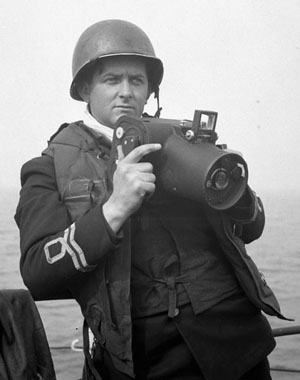
Lieutenant Gilbert Milne of the Royal Canadian Naval Volunteer Reserve, four days before D-Day, with his Fairchild K-20 camera. (Photographer: Richard Arless; Library & Archives Canada a163920)
The Photographer
Gib Milne was born in Medicine Hat, but grew up in Toronto, apprenticing in photography with his father, Charles Milne. Gib became a freelance photographer for the Toronto Star and in early 1943 was offered a commission as a photographer in the Royal Canadian Navy. After joining up at HMCS York in Toronto, Sub-Lieutenant Milne reported for duty in Halifax. He spent the next year covering the movements of the RCN and recording the pre-invasion schemes of destroyers, minesweepers, motor torpedo boats, and landing craft infantry.
In the lead-up to D-Day, Milne was sequestered with elements of 9th Brigade on the Southampton Hards in the south of Great Britain, photographing the embarkation of soldiers onto the RCN 262nd LCI Flotilla. He was aboard LCI 306 when the flotilla weighed anchor and headed into the English Channel. On the morning of D-Day, Milne photographed the Channel crossing and the landing of the flotilla at Bernières-sur-mer where he shot ninety-two photos of Canadian 9th Brigade disembarking onto Juno Beach.
The Brigade
The 9th Brigade was the Canadian 3rd Division's reserve brigade. It was made up of three highland infantry regiments who were to land behind the First Wave after the Juno beachhead was secured by 7th & 8th Brigades. Then the 9th would move forward on paratrooper-style bicycles, on the backs of tanks, or in universal carriers, to an assembly point near Bény-sur-mer code-named ELDER. There, they would re-form into their fighting components and leap-frog through the lead brigades, taking control the attack in the afternoon of June 6th.
Gilbert Milne’s photos of D-Day culminate with the disembarkation of the highland brigade troops – for once off the ships the troops disappear into the Norman countryside. Milne was, after all, a Navy photographer. But it was Milne who captured some of the most iconic photos of this monumental Canadian enterprise. His photographic essay of the Channel crossing and 9th Brigade's amphibious landing were among the first images of the invasion to be released, immediately gaining worldwide attention.
Continue below, as MLU presents a sequenced analysis and deconstruction of some of Lieutenant Gilbert Milne’s D-Day photography.
*****
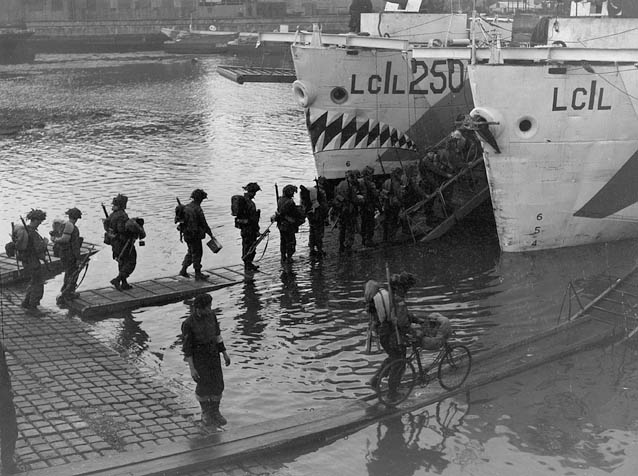
LAC caption: Troops of the Highland Light Infantry of Canada going aboard an L.C.I.(L) at dawn. Date: 6 June 1944. Place: Southampton, England.
MLU note: Date above is incorrect. This photo is taken at dawn on June 4th when the marching parties embarked on their LCI on the Southampton hards. At this point, D-Day was still scheduled for June 5th. News of delay didn't come until the men had been loaded aboard. These two LCI(L) are part of the Canadian 262nd Flotilla. LCI(L) stands for Landing Craft Infantry (Large). The LCI(L)'s troop capacity was about 190 soldiers — almost two rifle companies. From the photo below we know the ship on the right in the photo above is LCI(L) 125. (Photographer: Gilbert Milne; Library and Archives Canada a129059)
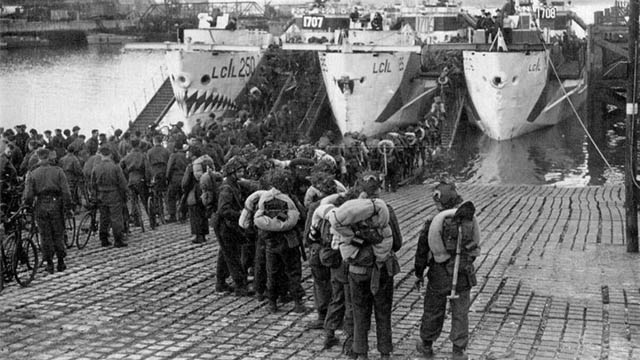
MLU note: Canadian troops of the Highland Light Infantry in Southampton on June 4th, embarking aboard LCI 250, LCI 125, and LCI 306. Each LCI had a serial number board affixed to her bridge for easy identification by the troops boarding. (These three ships are 1707, 1706, and 1708 respectively.) 1707 embarked 'B' Company and Battalion HQ of the Highland Light Infantry of Canada (HLI). 1706 embarked 'A' Company and 1st platoon of 'D' Company of the HLI. And 1708 embarked 'C' and 'D' Companies of the HLI.
The three LCI above should be able to embark the marching parties of a full regiment. The vehicle parties such as Support Company and the support echelons would embark on Landing Craft Tank or Rhinos, elsewhere, such as Stokes Bay. (Photographer: Gilbert Milne; Library and Archives Canada - a133121)
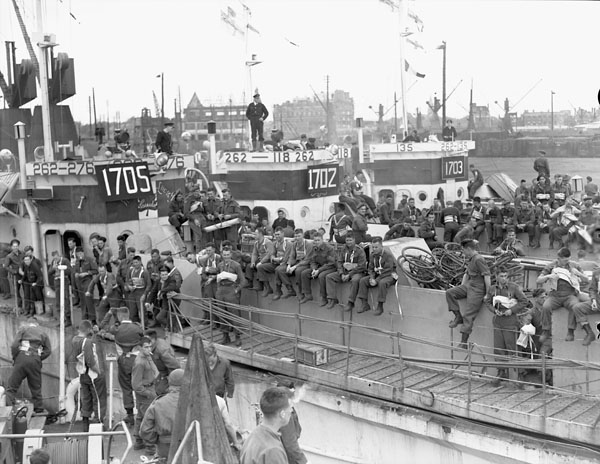
LAC caption: Canadian infantrymen en route to France aboard the Landing Craft Infantry LCI(L)s 276, 118 and 135 of the 2nd Canadian (262nd Royal Navy) Flotilla, Southampton, England, June 1944.
MLU note: Probably June 4th (or the morning of the 5th). Several craft from Canadian 262nd LCI flotilla are moored together, not "en route", but still in harbour in Southampton. The serial numbers on the front of each bridge refer to serials of Operation Order No.1 of 9th Canadian Brigade, 3rd Canadian Division. Serial numbers 1702 and 1703 carried members of the North Nova Scotia Highlanders (based in Amherst, Nova Scotia). 1705 was a mixed load carrying members of the Highland Light Infantry of Canada, Stormont Dundas & Glengarry Highlanders, the Defence and Employment Platoon of 9 Brigade Headquarters and members of the Canadian Provost Corps.
In this photo, the men have doffed their helmets and gear (and rifles it seems) probably in the bunks below deck. The LCI didn't cast off till the afternoon of the 5th, when the flotilla moved down the Southampton channel. In the evening of the 5th they passed between the Isle of Wight and Portsmouth into the open sea where they would regroup. (In Southampton on June 5th the sun sets at 9:14pm.)
Compare this photo against the photo below which is also LCI 276 (#1705 – "Lucky" with the Cdn maple leaf that says "Canada".) (Photographer: Gilbert Milne; Library and Archives Canada a115614)
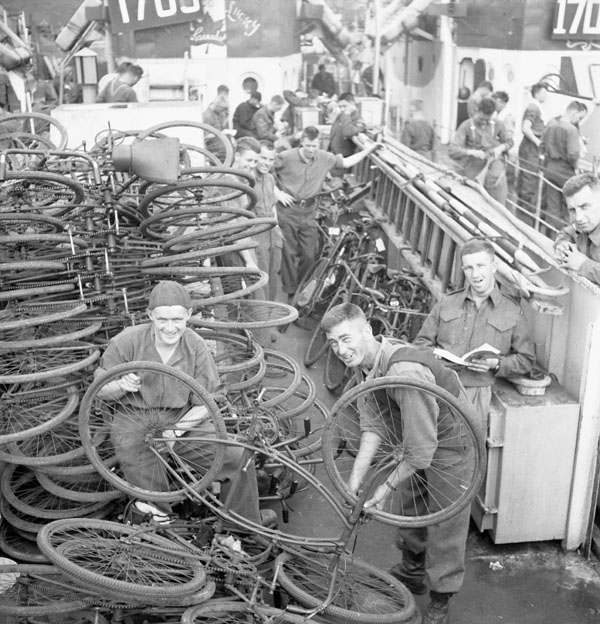
LAC caption: Infantrymen checking bicycles aboard an LCI(L) of the 2nd Canadian (262nd RN) Flotilla. Southampton, England, 6 June 1944. (L-R): Privates Reg Martin and Rodney MacNeill, both of The Lorne Scots (Peel, Dufferin and Halton Regiment); Private George Banning of The Cameron Highlanders of Ottawa (MG).
MLU note: Obviously not June 6th. Probably June 4th (or the morning of the 5th). The LCI are still in harbour in Southampton. The rifle companies have loaded aboard, but the men have unloaded their fighting gear probably in the bunks below deck. The bicycles were supposed to speed the second wave regiments to the front once they disembarked from the LCI, but the roads were far too congested and the bikes were rarely if ever used. D-Day veterans say a lot of French kids got new bikes that day. Compare this photo against the photo of LCI 276 above. (#1705 – "Lucky" with the Cdn maple leaf that says "Canada".) 1705 was a mixed load carrying members of the HLI, SD&G Highlanders, the Defence and Employment Platoon of 9th Brigade HQ and members of the Canadian Provost Corps.
 The official LAC photo caption suggests two men above are from The Lorne Scots regiment, and one of our readers has helped identify them:
The official LAC photo caption suggests two men above are from The Lorne Scots regiment, and one of our readers has helped identify them:
D.R. Martin (Regimental #C21725) was taken on strength as a Private in 9th Infantry Brigade Ground Defence Platoon on 21 April 1944, just in time for D-Day. The 9th Brigade Defence Platoon were members of The Lorne Scots (Peel, Dufferin and Halton Regiment).
L.R. MacNeill (Regimental #B49530) was taken on strength as Trooper in No. 11 Defence Platoon on 7 Jul 1942. With that regimental number, MacNeill probably signed up with the Grey & Simcoe Foresters. Originally an infantry unit, like the Sherbrooke Fusiliers and Halifax Rifles, the Foresters were re-designated as armoured. And like the Halifax Rifles, its overseas members were split up in the UK to fill out other units. By D-Day it appears MacNeill is a member of the Lorne Scots. (Photographer: Gilbert Milne; Library and Archives Canada a136999)
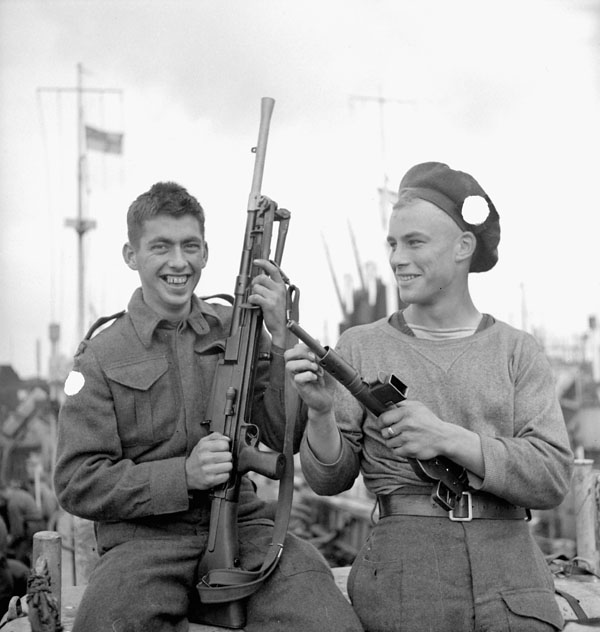
LAC caption: Infantrymen of the 9th Canadian Infantry Brigade aboard an LCI(L) of the 2nd Canadian (262nd RN) Flotilla, Southampton, England, 6 June 1944. (L-R): Privates Art Robertson and Ken Marden.
MLU note: Probably June 4th (or the morning of the 5th) – the LCI are still in harbour in Southampton as suggested by the masts in background. RCN #262 Flotilla didn't cast off till the afternoon of the 5th, when the LCI moved down the Southampton channel. In this photo, Robertson holds a Bren gun and Ken Mardon (misspelled above) holds a Sten gun (though privates carried rifles so this must be borrowed from a section leader). Both men (boys really it seems) are sharing a laugh while waiting for the show to start. The wartime photo censor has whited out their regimental markings, but we know from a similar uncensored photo that Mardon wears a Highland Light Infantry cap badge. And it looks like there is a 'Canada' flash below the shoulder flash on Robertson, suggesting he is a North Nova Scotia Highlander.
Ken Mardon would be mortally wounded on July 8th at the second battle for Bloody Buron. Given his place and date of death – in England on July 12th – we can deduce that Ken died of wounds after being evacuated back to the UK. He was 19. (Link to Ken Mardon at CWGC.) (Photographer: Gilbert Milne; Library and Archives Canada a136997)
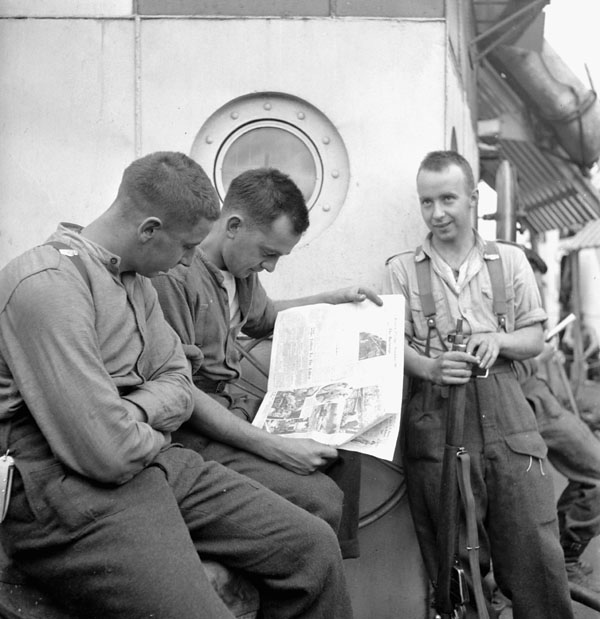
LAC caption: Infantrymen of the 9th Canadian Infantry Brigade aboard an LCI(L) of the 2nd Canadian (262nd RN) Flotilla reading the news of the Canadian entry into Rome. Southampton, England, 6 June 1944. (L-R): Lance-Corporal Bill Dudka, Privates Leo Janisse and Leon Ruston.
MLU note: Bill Dudka (brother of MLU interviewee Stan Dudka) was in the Provost Corps, so this photo is most likely taken on LCI 276 (#1705 - "Lucky" with the Cdn maple leaf that says "Canada") as seen in photos above. LCI 276 was a mixed load carrying HLI, SDG Highlanders, the Defence and Employment Platoon of 9th Brigade HQ and members of the Canadian Provost Corp. If so, this LCI is still in port in Southampton because when the flotilla departs, photographer Milne is on LCI 306.
Though many of the LAC official descriptions are incorrect, this caption does state the LCI is still in Southampton. Interestingly the official LAC caption says Bill Dudka and friends are reading about the liberation of Rome, which was June 4th. Canadians from the First Special Service Force (Devil's Brigade) were among the first into Rome. So this photo is probably June 5th before the LCI unmoor from Southampton that afternoon. (Photographer: Gilbert Milne; Library and Archives Canada a136998)
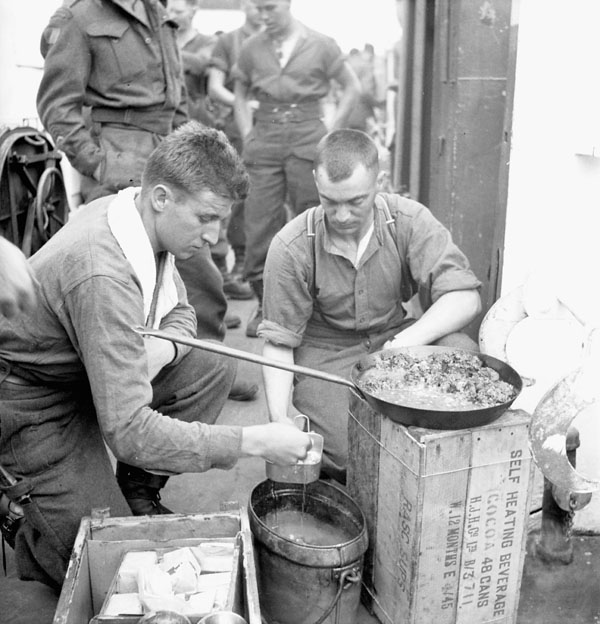
LAC caption: Infantrymen of The Highland Light Infantry of Canada cooking a meal aboard LCI(L) 306 of the 2nd Canadian (262nd RN) Flotilla en route to France on D-Day, 6 June 1944.
MLU note: The LAC description says they are on route to France on D-Day. If so it would be the early morning of June 6th. Once RCN 262nd LCI Flotilla unmoors at Southampton, Gib Milne is aboard LCI 306 with the HLI. This could be supper on the 5th, though we can tell from photo PA-136981 below that the men were still pretty casually dressed for breakfast in the early a.m. of June 6th.
The LCI flotilla didn't cast off till the afternoon of the 5th, when the LCI moved down the Southampton channel. In the evening of the 5th they passed between the Isle of Wight and Portsmouth into the open sea where they would regroup. The man standing in battle dress behind the men cooking looks to have Highland Light Infantry of Canada shoulder flash. (Photographer: Gilbert Milne; Library and Archives Canada a136983)
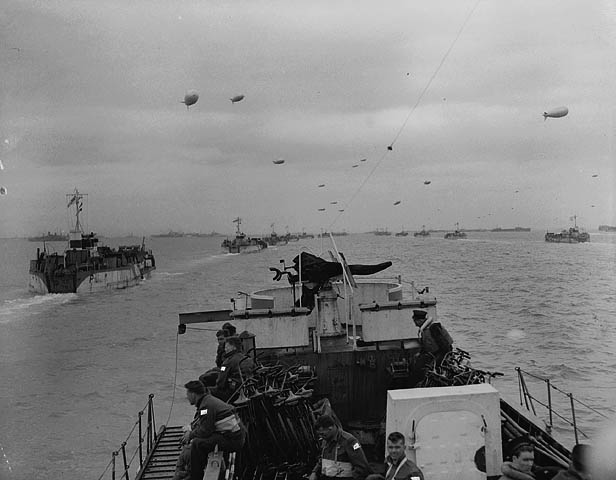
LAC caption: View from LCI(L) 306 of the 2nd Canadian (262nd RN) Flotilla showing ships of Force 'J' en route to France on D-Day, 6 June 1944, English Channel.
MLU note: RCN photographer Gib Milne takes this photo from the bridge of LCI 306, looking over the bow at the other LCI headed towards Normandy. Each LCI carries an anti-aircraft dirigible overhead. Note the cable heading skyward from the bow of this LCI. Also note the bow gun is still covered. LCI 306 looks like it's coming into the strict line of the LCI convoy in front. (Compare this photo with photo below.)
The men of the HLI in the photo above are still dressed casually so this must be very early in the morning. Sunrise at the latitude of Portsmouth at this time of year was about 4:50 a.m. since the southern coast of Britain is at the same latitude as northern Newfoundland. Note the white censor marks on the shoulders. Other men would be sleeping in the bunks below deck which is through the white door. (Photographer: Gilbert Milne; Library and Archives Canada a137014)
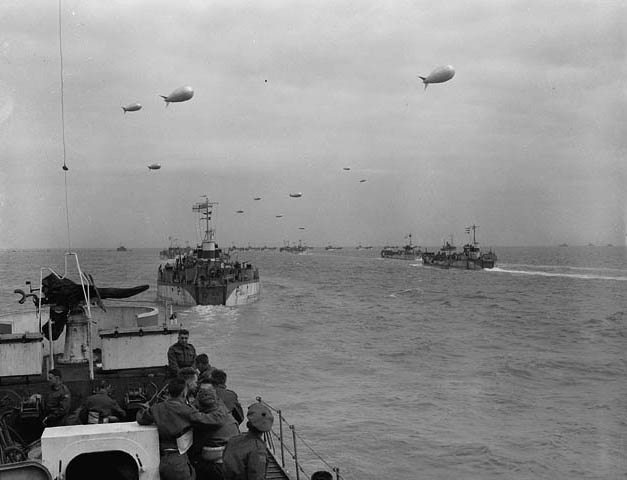
LAC caption: Invasion craft en route to France on D-Day, 6 June 1944, English Channel.
MLU note: Still looking over the bow of LCI 306 at the other LCI headed towards Normandy – a little later than the photo above since the LCI has now fallen in line with the others in the flotilla. Each LCI carries an anti-aircraft dirigible overhead. The anti-aircraft gun on the bow is still covered, but the door to the bunks below is now open. The men of the HLI are still dressed casually so this must be very early a.m. Sunrise at the latitude of Portsmouth at this time of year was about 4:50 a.m. (Photographer: Gilbert Milne; Library and Archives Canada a116339)
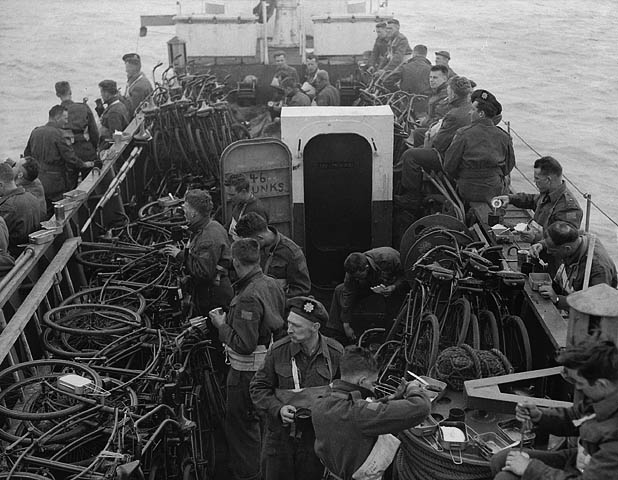
LAC caption: Infantrymen of The Highland Light Infantry of Canada aboard LCI(L) 306 of the 2nd Canadian (262nd RN) Flotilla en route to France on D-Day, 6 June 1944.
MLU note: A Gib Milne photo from the bridge of LCI 306, looking at the men and bicycles in the bow. Note the HLI cap badge on the balmoral in the foreground. More men have emerged from the bunks below. The men of the HLI are still dressed casually and eating compo rations for breakfast. HMCS LCI(L) 306 embarked 'C' and 'D' companies of the Highland Light Infantry of Canada. The HLI were based in Galt, Ontario. (Photographer: Gilbert Milne; Library and Archives Canada a136981)
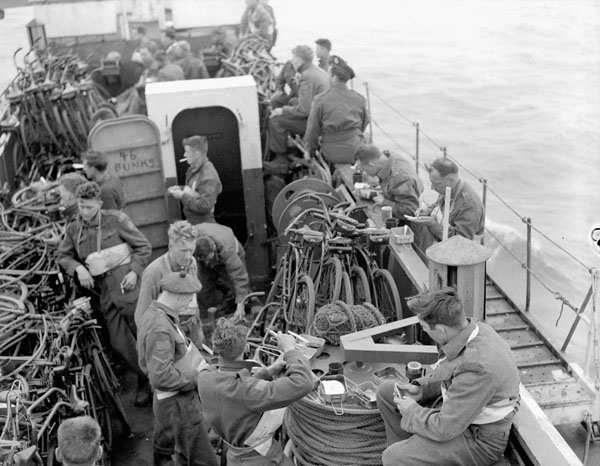
LAC caption: Infantrymen of The Highland Light Infantry of Canada aboard LCI(L) 306 of the 2nd Canadian (262nd RN) Flotilla en route to France on D-Day, 6 June 1944.
MLU note: Looking at the bow of LCI 306 headed towards Normandy. Compare this photo with the one above taken in tandem. The soldier with the balmoral is still in the front and the men eating breakfast along the sides. (Photographer: Gilbert Milne; Library and Archives Canada a136980)
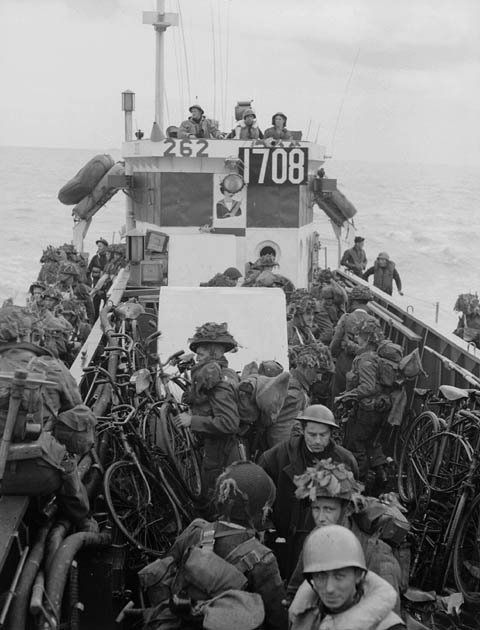
LAC caption: Canadian troops aboard LC(I)L 306 of the 262nd Flotilla, R.C.N., en route to France.
MLU note: Photographer Gib Milne has now moved to the Anti-Aircraft bow gun position (seen in photo a137014 above) to look back and take this photo of LCI 306's bridge. The vessel was serial carded #1708 on this day. The man on the bridge right above the number 262 is most certainly Lieutenant Andrew K. Stephens, Commanding Officer of LCI(L) 306. On the bow deck among the infantry, two naval personnel are in the foreground of this photo. One with the round American-style navy helmet, and the man walking towards the bow in the 'tin hat' who is probably the bow gunner. The men of the HLI are now fully kitted and getting ready for a landing in Normandy. (Photographer: Gilbert Milne; Library and Archives Canada a132930)
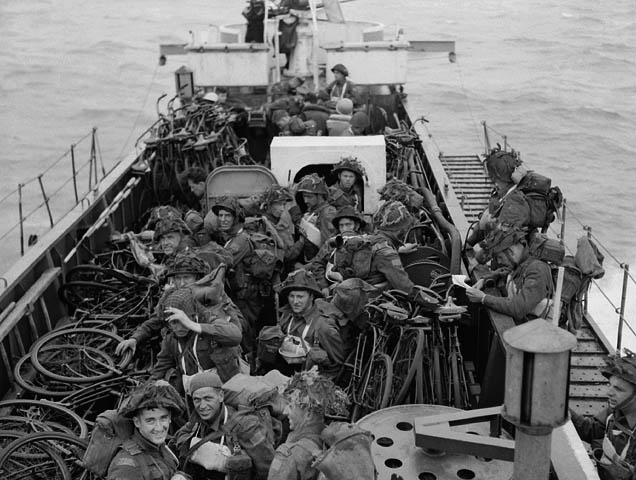
LAC caption: Personnel of the Highland Light Infantry of Canada and the North Nova Scotia Highlanders aboard LCI(L) en route to France.
MLU note: The info on the NNHS is inaccurate. These men are from 'C' and 'D' Companies of the HLI. Gib Milne is on the ship's bridge again, looking forward towards the bow of LCI 306. Note the Oerlikon anti-aircraft gun in the bow is now uncovered and manned, probably by the 'tin hat' naval gunner in photo a132930. Note the American-style helmeted navy rating from the photo above is up front in the bow as well. Standing in the door, Corporal Frank Weitzel would be killed at Bloody Buron on July 8th. (Link to Frank Weitzel at CWGC. He is buried in nearby Bény-sur-Mer Canadian War Cemetery.)
The LCI(L) had four 20mm Oerlikon anti-aircraft gun positions. One forward at the bow, one on top of the deckhouse and two more on the after deck. The men of the HLI are now fully kitted and getting ready for their imminent landing in Normandy. Note these 3rd Division soldiers are wearing the British pattern Mk III steel helmets. The Mk III, also called "turtle helmet" because of its shape, was issued in 1944 and supplied in priority to British and Canadian assault troops on D-Day, except support troops and commandos. It is often called the 'Canadian helmet' because it was thoroughly adopted by Canadian 3rd Division which often distinguishes them in photos from British troops and Canadian troops in other divisions. (Photographer: Gilbert Milne; Library and Archives Canada a133757)
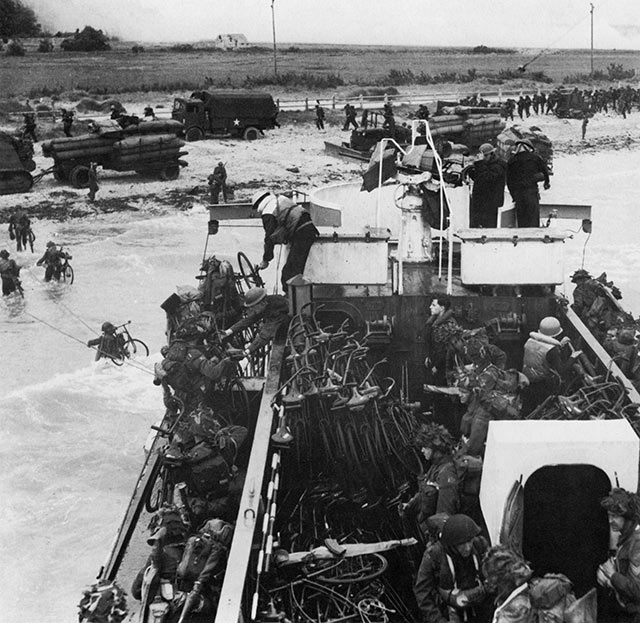
MLU note: D-Day 6th June 1944. The port and starboard ramps are down and 'C' and 'D' Companies of the Highland Light Infantry disembark from LCI 306 at Bernières-sur-mer. Navy personnel, including the American-style helmeted rating, are handing the bicycles over the bulkhead wall as the infantry move toward the ramps. (This must be one of Gib Milne's first disembarkation shots since he soon moves from this position onto the bow gun platform.) In this photo, the anti-aircraft Oerlikon gun crew is in the bow. Note the white painted metal tube ‘taboo’ fitted behind the Oerlikon. This structure stops a gunner who is concentrating on tracking low flying aircraft from shooting bits off his own vessel – a convenient protective feature. (Source is LAC, but this is scan from book. LAC ID uncertain, but possibly a135964)
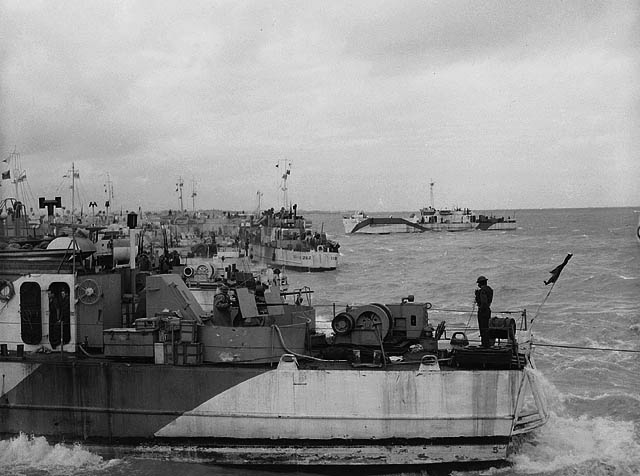
LAC caption: View looking west along 'Nan White' Beach, showing LCI(L)s of the 2nd and 3rd (262nd and 264th RN) Flotillas landing personnel of the 9th Canadian Infantry Brigade on D-Day.
MLU note: Gib Milne is still on the bridge of LCI 306 looking west along Juno towards the other LCI landing between Bernières and Courseulles. LCI 125 is in the foreground. You can see the two 20mm Oerlikon guns on the after deck. Especially note the cable line leaving the stern. In an LCI(L), along with other types of landing craft, the stern has a deeper draught and the bow is shallower so you can run the vessel up onto the beach. The difficult part, of course, is to get back out to sea. To assist with this task a large stern anchor is fitted, which is dropped from the stern on the final run into the landing. Once the troops disembark, then the rear winch, which you can see in this photo, would pull on that anchor and so pull the craft back off the beach and into deeper water. Note the naval rating on the stern with a communication link to the bridge. (Photographer: Gilbert Milne; Library and Archives Canada a136987)

LAC caption: Canadian LCI(L)s going ashore on D-Day.
MLU note: Milne is still on the bridge of LCI 306 taking this photo. Behind the card numbering this craft as #1706 – as we saw in the Southampton photos – this is LCI 125 (loaded with HLI). On the far side of this craft is LCI 135 (loaded with North Novas). The ramps on either side of the bow on LCI 125 are about to be lowered and the soldiers are lined up along the gunwhales with their bicycles. This vessel sustained damages in landing. It was holed by obstacles in the bow causing a 15° list which had to be corrected by the counter floating of ballast tanks. (Photographer: Gilbert Milne; Library and Archives Canada a145349)
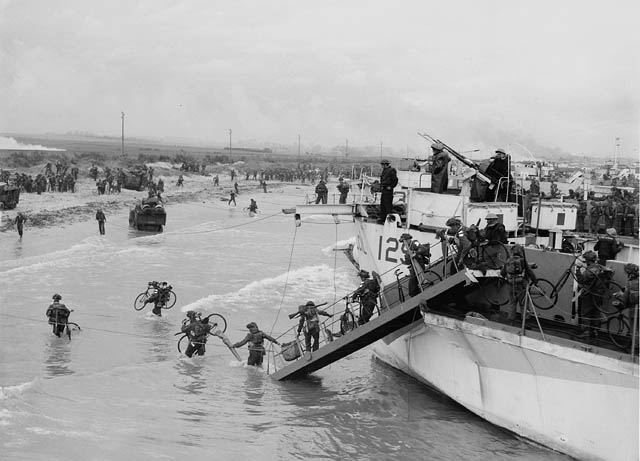
LAC caption: Troops of the Nova Scotia Highlanders and the Highland Light Infantry of Canada landing at Bernières-sur-Mer, 6 June 1944. Disembarking from L.C.I. of the Canadian Landing Craft Infantry (Large) Flotilla, of either the 260th, 262nd, or 264th.
MLU note: We know LCI 125 carried 'A' Company and 1st Platoon 'D' Company of the HLI, not the NNSH, though the NNSH are on the next vessel over. Photographer Gib Milne has now moved up to the bow gun platform of LCI 306 to take this photo of LCI 125. The ramps on either side of her bow are now down and the HLI soldiers are wading onto French soil with their bicycles. We also know that all of the craft we can see are part of the 262nd Flotilla. (Photographer: Gilbert Milne; Library and Archives Canada a116533)
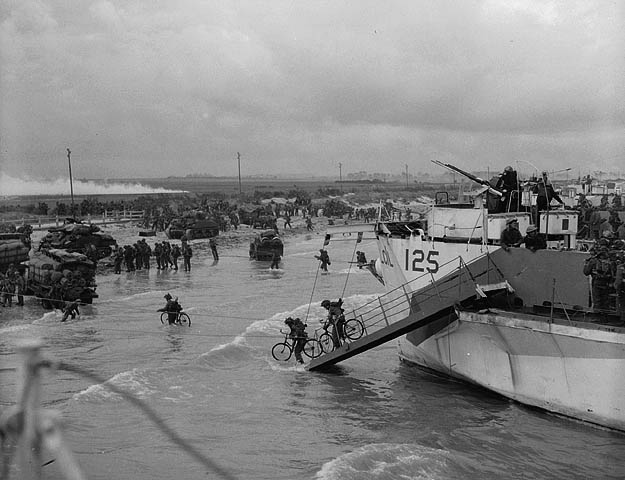
LAC caption: Personnel of the 9th Canadian Infantry Brigade landing from LCI(L) 125 of the 3rd Canadian (264th RN) Flotilla on 'Nan White' Beach on D-Day.
MLU note: Gib Milne takes this photo of LCI 125 from the bow gun position of LCI 306. Note the smokescreen masking the beaches in the middle ground. The village in the distance on the right of frame is Courseulles-sur-mer, where the Canadian 7th Brigade landed earlier that morning in the first wave. (Photographer: Gilbert Milne; Library and Archives Canada a137012)
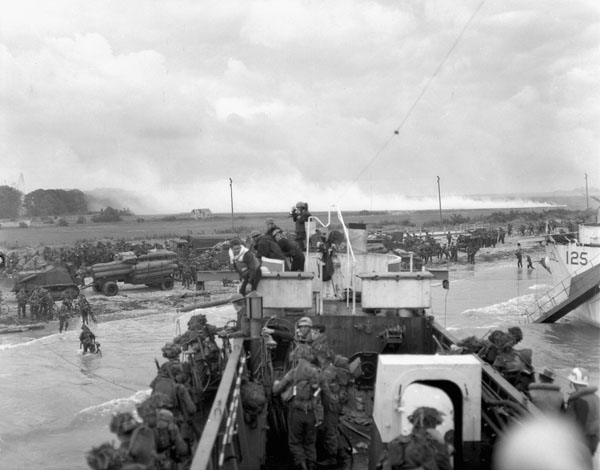
LAC caption: Infantrymen of The Highland Light Infantry of Canada aboard LCI(L) 306 of the 2nd Canadian (262nd RN) Flotilla, landing at Bernières-sur-Mer, France, 6 June 1944. The officer standing in the bow of the landing craft is Lieutenant Gilbert A. Milne.
MLU note: This photo is actually taken by Wallace McQuade, who happens to be taking a photo of Gib Milne taking photos from the bow gun platform. Yes, that's Milne with his Fairchild K-20 camera, the tallest person near the bow gun, behind the white 'taboo'. Milne is now facing east and taking some of the iconic D-Day shots of LCI 299 and the Bernières mansion, including the images that follow, below. The photo above also has a good view at the smokescreen which is wafting east towards Bernières-sur-mer. The anti-aircraft gunners don't look too interested in the sky. (Photographer: Wallace McQuade; Library and Archives Canada a137016)
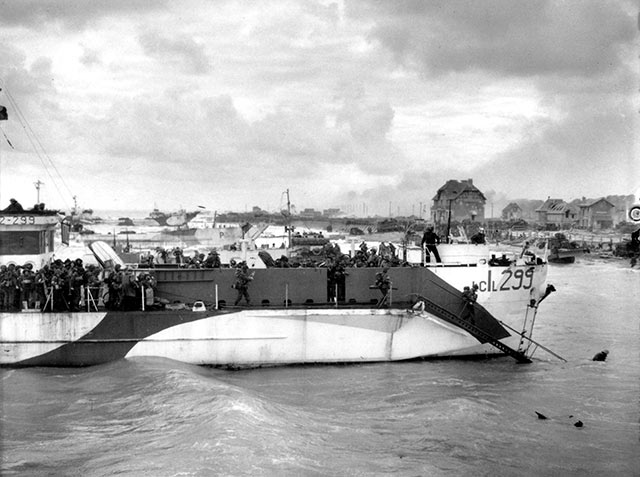
HMCS LCI(L) 299 has not quite nosed into position and the seawater is still pretty deep for the men working on the ramps. The Stormont Dundas & Glengarry Highlanders of the 9th Brigade, 3rd Infantry Division are about to wade ashore on Nan White Sector of Juno Beach in Bernières-Sur-Mer, Normandy on 6 June 1944. (Photographer: Gilbert Milne; Source is LAC, but ID uncertain.)
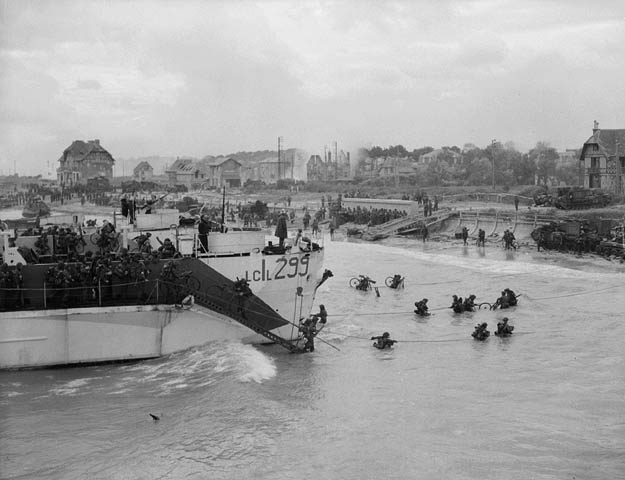
LAC caption: Personnel of the 3rd Canadian Infantry Division landing from L.C.I.(L) 299 of the 262nd Flotilla.
MLU note: Gib Milne is taking this iconic series of shots when another photographer, Wallace McQuade, takes a picture of him in the bow of LCI 306 (see photo a137016 above). LCI 299 has now nosed farther onto the beach and the men are moving down the ramps with their bicycles. The original DND caption once indentified these soldiers disembarking LCI 299 as members of the NNSH and HLI though subsequent research by Library & Archives Canada has identified the soldiers as SD & G Highlanders. Stormont, Dundas, and Glengarry are the three counties in Eastern Ontario from where the regiment was born, with armouries in Cornwall, Ontario. (Photographer: Gilbert Milne; Library and Archives Canada a131506)
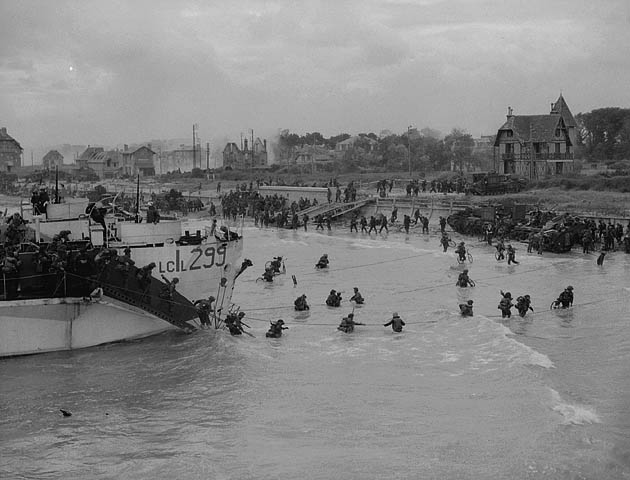
LAC caption: View looking east along 'Nan White' Beach, showing personnel of the 9th Canadian Infantry Brigade landing from LCI(L) 299 of the 2nd Canadian (262nd RN) Flotilla on D-Day.
MLU note: The beach is getting more congested as the offloading of the LCI flotillas continues. Notice the smoke in the village of Bernières itself near the train station (the two-level building with two chimneys). In landing, LCI(L) 299 hit a mine on its port side, putting holes in both the engine room and mess deck. It was badly damaged and de-commissioned by the Royal Canadian Navy in September 1944, then returned to the US Navy in March 1946. (Photographer: Gilbert Milne; Library and Archives Canada a137013)
MLU would like to thank Gilbert's son Michael Milne and the rest of the Milne family for their kind words and support.
Glenn Warner is a cinematographer, photographer, and photography historian.
If you have any observations, comments, insights, or see any errata, typos, or anything interesting when viewing these photos, please Contact Us. (Refer to photo reference numbers if possible.)







